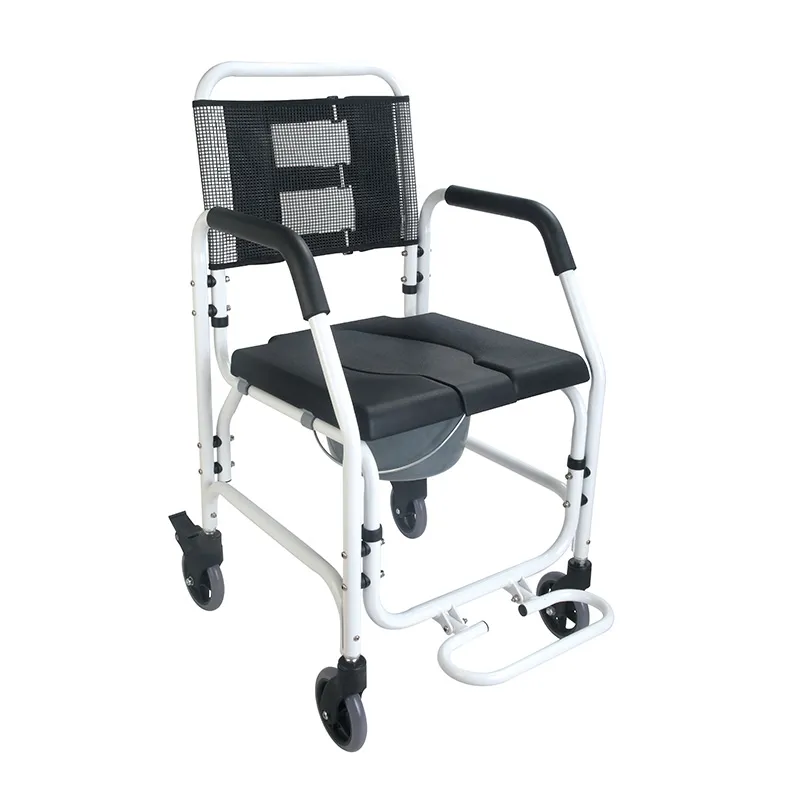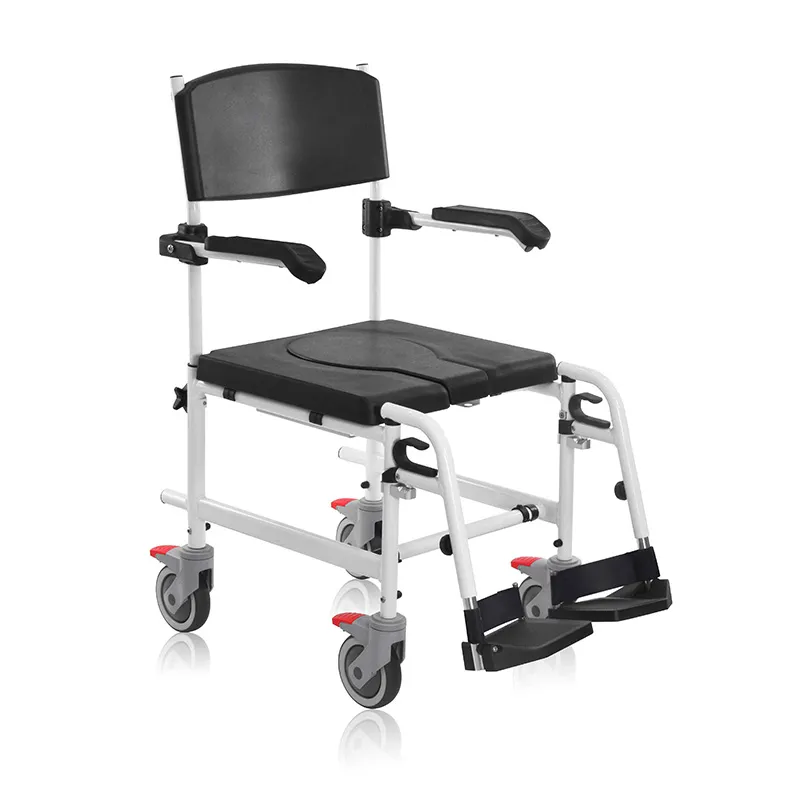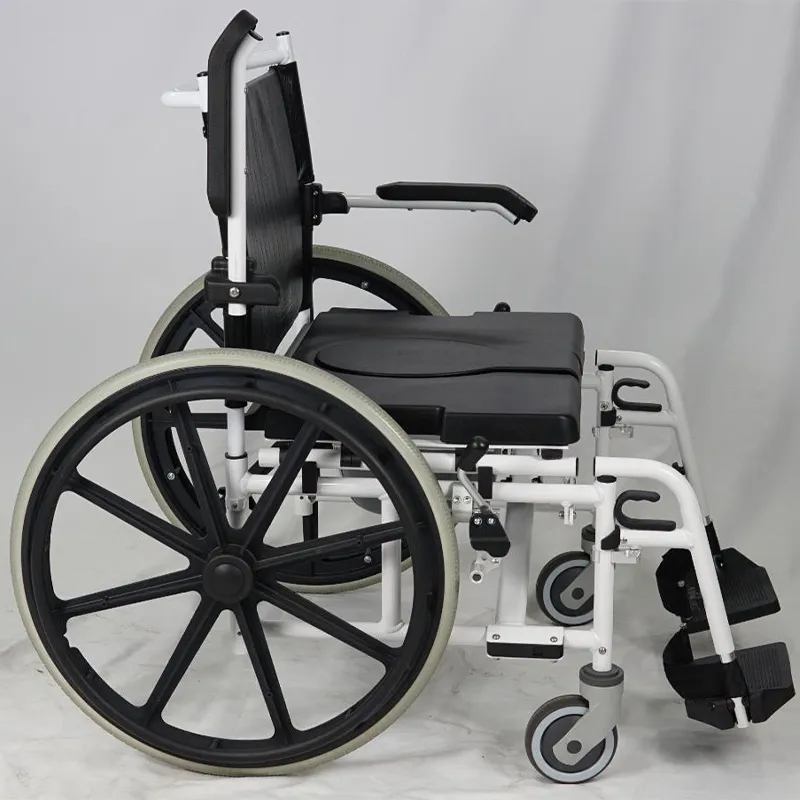
Qu'est-ce qu'un fauteuil roulant d'aisance ? Quels sont ses avantages et ses inconvénients ?
2024-07-19 15:30
As a specially designed assistive device, the toilet wheelchair provides great convenience for people with limited mobility to use the toilet.
This article will deeply analyze what a commode wheelchair is, as well as its main advantages and disadvantages, to provide readers with a comprehensive understanding and scientific basis for selection.

What is a commode wheelchair?
A commode wheelchair is a specially designed device that combines the functions of a wheelchair and a commode chair. Its main purpose is to help people with limited mobility in daily life, especially to provide support and convenience when using the toilet in the bathroom. A commode wheelchair is usually equipped with a removable seat, a toilet bowl, and an easy-to-clean design, allowing users to use the toilet without leaving the wheelchair.
Design features of a toilet wheelchair:
1. Portability: The commode wheelchair is equipped with wheels, which can be easily moved between the room and the bathroom. Some designs also have a foldable function for easy storage and carrying.
2. Versatility: Most commode wheelchairs can be used as ordinary wheelchairs, directly above the toilet, or equipped with a separate toilet bowl.
3. Comfort: Considering the long-term use of users, commode wheelchairs usually adopt padded seats and ergonomic design to improve comfort.
4. Easy to clean: The material and structural design of commode wheelchairs are easy to clean and disinfect to ensure hygiene.

What are the advantages of commode wheelchairs?
Advantages of commode wheelchairs: improve the independence of elderly and disabled people with limited mobility, reduce the risk of falls and injuries during toileting, provide high comfort, reduce the burden of carrying and moving patients, and versatility.
1. Improve independence
For elderly and disabled people with limited mobility, toilet wheelchairs provide great autonomy. Users can go to the toilet on their own without the help of others, which improves their independence and self-esteem in life.
2. Safety
Commode wheelchairs provide stable support, reducing the risk of falls and injuries during toileting. Many commode wheelchairs are equipped with non-slip foot pads and safety locking devices, which further improve the safety of use.
3. Comfort
Commode wheelchairs are designed with users' long-term use needs in mind, usually with padded seats and ergonomic structures, providing high comfort. Some advanced models are also equipped with backrests and armrests, which further increase the comfort.
4. Convenient care
For caregivers, commode wheelchairs make it more convenient and safer to help patients go to the toilet. Caregivers can easily push and fix the wheelchair, reducing the burden of carrying and moving patients and reducing the risk of accidental injuries.
5. Versatility
The multifunctional design of the commode wheelchair allows it to be used not only in the bathroom, but also as a regular wheelchair for activities inside and outside the home. Some commode wheelchair designs are also equipped with a detachable commode for easy use outside the bathroom.

What are the disadvantages of commode wheelchairs?
Disadvantages of toilet wheelchairs: heavier weight and larger size, higher cost, limited by the use environment, difficult to adapt, and troublesome cleaning and maintenance.
1. Weight and volume
Although many commode wheelchairs are designed to be lightweight, their functional complexity usually makes them heavier and larger than ordinary wheelchairs. This may cause inconvenience when storing and carrying, especially in environments with limited space.
2. High cost
High-quality commode wheelchairs are usually expensive, and for some families with limited financial conditions, purchasing a commode wheelchair may bring certain financial pressure. In addition, the repair and maintenance costs of some models are also high.
3. Restricted by the use environment
Commode wheelchairs may be restricted in some small or uneven environments. For example, in stairwells or narrow bathrooms, the operation and movement of commode wheelchairs will become difficult.
4. High difficulty in adaptation
Some users, especially the elderly who use toilet wheelchairs for the first time, may need time to adapt and learn how to use them correctly. If they are not operated properly, they may increase the risk of falling or injury.
5. Troublesome cleaning and maintenance
Despite the easy-to-clean design, commode wheelchairs still require regular cleaning and maintenance to ensure their hygiene and normal function. This may be an additional burden for some users and caregivers.

Actual case analysis
Case 1: Daily use of the elderly
Ms. Li, 85 years old, has difficulty in moving due to a stroke. In order to facilitate her daily life, her family bought a high-end commode wheelchair. Ms. Li said:
Advantages:
● Improved independence and self-esteem.
● Provides stable support and ensures safety.
Disadvantages:
● Commode wheelchairs are heavy and inconvenient to operate in a small bathroom.
● High-end commode wheelchairs are expensive and put great financial pressure on people.
Case 2: Application in Nursing
Mr. Wang, 65, was paralyzed in his lower limbs due to a car accident and used a toilet wheelchair for daily care in a rehabilitation hospital. The nursing staff said:
Advantages:
● Reduced the burden on nursing staff.
● Provided a safe and convenient way of nursing.
Disadvantages:
● Requires regular cleaning and maintenance, which increases the workload of nursing.
● Difficult to operate on some uneven surfaces.
Conclusion
As an important assistive device, toilet wheelchair has significant advantages in improving the independence of people with limited mobility, ensuring safety and convenient care. However, it also has certain disadvantages in weight and volume, cost, restrictions on the use environment, difficulty in adaptation, and cleaning and maintenance.
When purchasing a commode wheelchair, it is necessary to comprehensively consider the specific needs of the user and the use environment to ensure that the commode wheelchair purchased can provide the best support and convenience.








